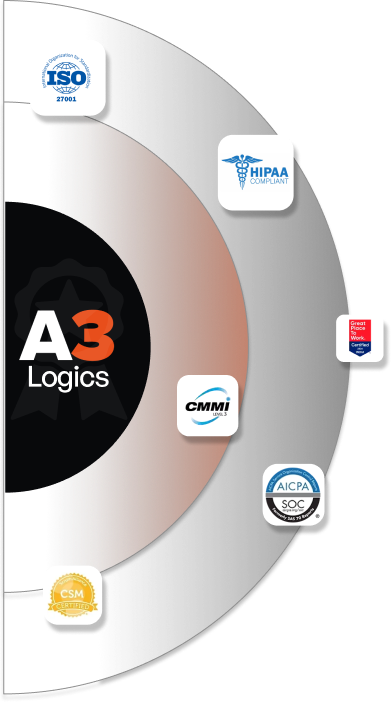When you use Power BI, you get the most up-to-date tools for data analysis and visualization, such as broad integration capabilities and a large choice of options. Power BI is offered in a variety of services and licenses, each with unique functionality and applications, including Power BI Embedded.
Microsoft Power BI holds an estimated 13.84% market share in the business intelligence category, ranking it as the second most popular BI tool. Power BI is a popular business reporting platform for a variety of reasons, including its analytical powers, flexibility to interact with numerous platforms, systems, and software, and data visualization and governance features.
Many Microsoft Power BI partners have been utilizing this toolkit to create applications for years. According to a 2025 Reveal Survey, 81% of companies have adopted embedded analytics solutions like Power BI Embedded.
In this article, we will explain what is Power BI Embedded service and how to make the most of it.
Table of Contents
What is Power BI Embedded?

So, what is Power BI Embedded? One Azure solution that enables you to incorporate Power BI’s embedded analytics functionality with other apps is Power BI Embedded. To put it another way, Power BI Embedded gives businesses the ability to generate reports and examine data using their own web sites, portals, or applications.
In contrast to Power BI Pro or Power BI Premium, Power BI Embedded does not offer an environment for accessing corporate reports and instead depends on external APIs. Developers and software firms, commonly referred to as ISVs that write programs, can include Power BI features or add reports into their own apps by turning on Power BI Embedded.
Therefore, if you wish to incorporate dashboards and business intelligence features into particular applications or programming environments, Power BI Embedded can be helpful. It isn’t helpful, though, for enforcing data governance policies, evaluating business performance, or gaining access to all of your company’s reports and dashboards.
Why Use Power BI Embedded?
Users want to see real-time intelligence in their hands—at their fingertips—without having to switch between tools. That’s where Power BI Embedded comes into its own. As a SaaS provider, enterprise developer, or product team, embedding Power BI reports natively within your app can unlock significant benefits. Let’s discuss the most important reasons why Power BI Embedded is being considered an excellent option for modern analytics integration.
1. Better User Experience through In-App Analytics
One of the largest benefits of Power BI Embedded is the easy analytics experience it provides your users. Rather than exporting data or changing to another BI tool, users can tap into dynamic reports, visualizations, and dashboards directly in your app. Not only is this a time-saver, but it keeps users within their workflow—resulting in better engagement, quicker insights, and more intelligent decisions.
2. White-Label Capabilities
Brand consistency is important when providing customer-facing software. Power BI Embedded enables you to control the appearance and feel of reports so they match your application exactly. You can strip out all Power BI branding with complete white-labeling support and customize the experience using your fonts, logos, and color schemes. This level of customization helps enhance your brand presence while providing a professional, integrated analytics experience.
3. No End-User Power BI Licenses Needed
Another one of the benefits of Power BI Embedded is that it makes licensing easy. Your users or customers don’t require separate Power BI Pro or Premium licenses. Your organization, instead, manages licensing as part of Azure capacity. Centralized management reduces administrative burden and decreases obstacles to adoption—making it simple to scale access to analytics across your users.
4. Data Security and Role-Based Access
Concerned about sensitive information? Power BI Embedded’s got you covered. It’s compatible with Row-Level Security (RLS) and role-based access, so you can make sure users only view the data that’s applicable to them. Whether you’re working with financial information, healthcare information, or internal analytics, you’ll remain compliant with privacy and security regulations. You own the data. You set the rules.
5. Pay-As-You-Go Pricing Model
Another huge plus is the scalable pricing model. With Power BI Embedded, you pay just for the capacity you consume—no large upfront licensing fees. This pay-as-you-go method is ideal for startups, ISVs, or even enterprise groups that need to scale analytics without expanding the budget. You can begin small and grow capacity as your user base or data requirements expand.

Key Features of Power BI Embedded
Without the hassle of creating visualization features from scratch, Power BI Embedded turns your application into a data analytics powerhouse. These are some the best features of Power BI Embedded:
> An Architecture Based on APIs for Deep Integration
- Complete REST API access to automate the production and updating of reports
- JavaScript SDK for extensive customizations and client-side interactions
- smooth integration with any framework for online or mobile applications
- Direct command over the user interface and renderer
> Capabilities for Advanced Analytics
- Automatic report updates and real-time data processing
- AI-driven anomaly detection and data insights
- Options for specialized graphic development for particular business requirements
- Drill-down capabilities at multiple levels for in-depth data exploration
> Enterprise-Level Control and Security
- Row-level security for accurate control over data access
- Connecting your current authentication system
- Automated administration of user permissions
- Safe data transfer between several sources
> Adaptable Development Choices
- App-owns-data and user-owns-data models are available for selection.
- The ability to customize branding and theming
- Programmatic management of report filters and states
- Both DirectQuery and Import data modalities are supported.
> Contemporary Performance Elements
- Automatic caching and query optimization
- For big collections, incremental data refresh
- Scaling of resources dynamically according to consumption
- Options for cross-region deployment of worldwide apps
Benefits of Power BI Embedded

There are various benefits of Power BI Embedded a few major benefits include:
1. Fast and simple integration with current apps
Power BI Embedded integrates with current enterprise apps with ease, cutting down on development time and expense.
2. Interactive and customized visuals
By providing captivating data visualizations that can be tailored to particular business requirements, Power BI Embedded improves the user experience.
3. Enterprise-grade security and compliance
The application guarantees data security and adherence to relevant laws.
4. Frequent monthly updates
Users can fully utilize the analytical capabilities of this solution because it is kept up to date with the newest features and improvements.
5. Numerous customizable visualizations and data connectivity choices
The tool makes it simple to combine multiple data sources by providing a wide range of visualization and connectivity options.
6. Smooth interaction with interactive dashboards and reports and Excel
allows for the production of interactive and easily comprehensible dashboards and reports and connects seamlessly with Microsoft Excel.
7. Enhanced end-user experience
Enables administrators to personalize the navigation and interface, allowing end users to utilize only the functions they truly require.
7. Decreased time and effort spent on administration and support
Improves productivity and user experience by lowering the expenses of new user configuration, training, and support.
8. Operational data monetization and visibility
By expanding operational data visibility to consumers and strategic partners and monetizing portal access, this solution helps businesses boost income.
9. Better decision-making and adaptability
Power BI Embedded allows users to make better informed, data-driven decisions in real time and modify reports and visualizations in response to shifting business requirements by integrating data analytics capabilities straight into business applications.

Use Cases for Power BI Embedded
Power BI Embedded has revolutionized how organizations provide analytics. Through embedding interactive dashboards and reports within applications, it increases user engagement, streamlines data interpretation, and facilitates real-time insights without requiring users to leave the main product.
Whether you are a SaaS provider, enterprise, or developer, Power BI Embedded offers a versatile means to provide meaningful data experiences. Below are some of the most applicable use cases of Power BI Embedded in industries and applications.
> SaaS Applications
One of the most widespread use cases of Power BI Embedded is in SaaS applications that would like to make analytics a native capability. Instead of creating intricate data visualization software from the ground up, SaaS businesses can leverage Power BI Embedded to bring robust dashboards directly into their apps.
This enables users to examine their data within the product interface itself, enhancing usability and stickiness. For instance, a CRM system can insert reports that highlight real-time sales performance, customer trends, and campaign effectiveness—all without the use of external software.
Internal portals and team dashboards are a must in large organizations to monitor performance metrics. Power BI Embedded simplifies the process of aggregating data from different internal systems like HR, finance, and supply chain applications into one view.
Executives and team managers can view KPIs, project status, or risk indicators directly from an embedded dashboard within their intranet portal—without having to toggle between systems.
> Customer-Service
Another important application is customer-facing portals. Client-facing businesses—consulting firms, finance companies, and agencies—can streamline the time consuming creation of manual reports by giving clients self-service dashboards.
Features of Power BI Embedded can allow every client to log in and see tailored reports, data filtering, and trends specific to their account. This enhances client satisfaction as well as increases trust with data transparency.
> Healthcare
In the medical industry, Power BI Embedded allows patients and providers alike to view visual data insights while meeting rigorous regulations such as HIPAA. Medical applications can embed dashboards showing patient health statistics, treatment activity, or appointment calendars—all within a secure program. Doctors can easily analyze trends in patient vitals, while patients can more easily monitor their own health data.
> Retail and eCommerce
Retail and eCommerce sites also stand to gain significantly from Power BI Embedded. Sellers and merchants on these sites can see detailed analytics of product performance, customer activity, and sales trends. For example, an eCommerce solution can provide embedded dashboards indicating which products are best sellers, which areas are performing poorly, or where stock levels might need attention—all in real-time.
> Finance and banking
Wealth managers, bank clients, and financial planners heavily depend on real-time analytics to make decisions. Power BI Embedded enables wealth managers, bank customers, and financial planners to view dashboards analyzing portfolio performance, exposure to risk, and trends in the markets. This information can be securely provided through custom applications or mobile apps, ensuring a secure and seamless data experience.
> Education
Embedded analytics in the education space enable institutions to monitor student performance, attendance, and engagement. EdTech platforms can provide customized dashboards for teachers, students, and administrators—to gain insights into test results, course completion, or students at risk. This establishes a data-driven learning environment and enables educators to take timely action to enhance outcomes.
Whatever your sector – healthcare, fintech, education, or retail – use cases of Power BI Embedded provides a secure, scalable, and affordable means to transform raw data into interactive dashboards. It gives users the power of insights that inform smarter decisions and alleviates the development load on your team.
The Role of Power BI Embedded in Data Analytics
Power BI Embedded has a revolutionary role to play in contemporary data analytics, providing companies with the means to embed smart insights into their applications and workflows. Its sophisticated capabilities enable organizations to respond to data more quickly and accurately.
A. Real-Time Dashboards
Power BI Embedded provides real-time streaming of data so that users can visualize updates as they occur. Whether monitoring sales performance, changes in inventory, or system statistics, real-time dashboards allow decision-makers to have the most up-to-date information at hand. This functionality is critical to industries where accuracy and speed cannot be compromised.
B. Advanced Visualizations
From interactive maps and bespoke visuals to geospatial mapping and drill-down functionality, Power BI Embedded provides a broad range of advanced visualizations. These visuals turn raw numbers into engaging stories that expose trends, anomalies, and opportunities—making difficult data easy to grasp for all users, technical or not.
C. Data Modeling & Analysis
With strong data modeling features, Power BI Embedded enables users to establish relationships between datasets, calculate calculated measures, and construct reusable data models. This adds analytical depth and consistency throughout reports, supporting more advanced and scalable reporting models.
D. Predictive & Prescriptive Analytics
Power BI Embedded is compatible with integration with machine learning models and Azure Synapse for predictive and prescriptive analytics. Companies can predict trends, identify anomalies, and get actionable suggestions—shifting from past-reporting to forward-looking decision-making.
Power BI Embedded in Business Intelligence Services
Power BI Embedded is not only a product—it’s a business strategy for companies providing Business Intelligence (BI) solutions. It allows powerful analytics to be integrated into products and platforms without needing heavy infrastructure or licensing weight.
A. White-Label BI Solutions
With white-label support, companies are able to incorporate Power BI dashboards into their applications and label them as their own. Service providers can thereby provide branded, seamless analytics experiences to customers with low development overhead and quick time-to-market.
B. Role in SaaS Products
Power BI Embedded is extremely useful for SaaS businesses through direct integration of data visualization within their products. It saves customers the hassle of stepping out of the platform for analysis, ensuring that data insight is a natural component of the user experience. Also, it increases the product’s value without raising complexity levels for the customer.
C. Self-Service BI for Clients
Power BI Embedded enables clients with self-service analytics. Clients can filter through data, produce personalized views, and discover patterns without technical support teams. It makes data easily accessible, instills data-driven decision-making, and boosts satisfaction across sectors from banking to consumer products.
D. Multi-Tenant Architecture Support
For organizations hosting multiple customers via a single platform, Power BI Embedded enables secure multi-tenant implementations. Every tenant has its own customized experience with full data isolation, and hence it’s great for SaaS providers as well as platforms dealing with sensitive or customer-specific data.
Why Do Businesses Need Power BI Embedded?
The fact that this technology greatly improves data and content security is one of its advantages. Workspace-level security features are not the only ones included in Power BI Embedded. Additionally, it provides a feature that guarantees security and support at the report and data level, allowing the administrator to specify which users can view which data sets in a given report as well as which users can access which reports within the same workspace.
In conclusion, Power BI Embedded offers the following primary advantages:
- Enables you to control user access and activity, all reports, and more from one place.
- Make your own custom folder structure and distinct report categories.
- Makes it possible to create subcategories, which makes it easier for users to navigate and distribute reports.
- Allows you to share reports with anyone outside of your organization who does not have a Power BI license and does not require any professional licensing.
- Since there is no need to buy a license for each user, you save a substantial sum of money.
- It can be installed on-site or used in SaaS mode.
How to Get Started with Power BI Embedded?
Onboarding with Power BI Embedded is easy and starts by knowing your reporting and data needs.
1. Define Your Analytics Requirements
Identify what data your users need, how it should be visualized, and the level of interactivity required within your application.
2. Set Up a Power BI Workspace
Create and configure a Power BI workspace using your Microsoft Azure portal to manage and publish reports.
3. Create Reports in Power BI Desktop
Design custom reports using Power BI Desktop tailored to your application’s data insights and presentation needs.
4. Publish Reports to the Workspace
Once your reports are ready, publish them directly to your Power BI workspace in the cloud.
5. Embed Reports Using REST APIs or SDKs
Utilize Power BI REST APIs or SDKs to securely embed reports into your application for seamless user experience.
6. Manage User Access with Azure AD
Leverage Azure Active Directory (AD) for secure authentication and authorization—ensuring only permitted users view the embedded content.
7. No Need for End-User Power BI Licenses
Your users can access analytics without requiring individual Power BI licenses, reducing friction and cost.
8. Affordable and Scalable Pricing
Take advantage of Power BI Embedded’s flexible, pay-as-you-go pricing model that suits projects of all sizes.
9. Comprehensive Documentation
Microsoft provides thorough documentation to simplify setup and development, making onboarding faster and more efficient.

Why Choose A3Logics as Your Power BI Consulting Partner?
Selecting A3Logics as your Power BI consulting service partner entails collaborating with a team of experienced data professionals committed to turning your data into meaningful insights. With extensive experience in Power BI development, customization, and integration, we assist companies in creating solid reporting frameworks that enable real-time decision-making.
Our consultants are aware of varied industry requirements and provide customized dashboards, KPIs, and analytics models that meet your business objectives. Whether you want to integrate Power BI into your apps, transition from legacy BI systems, or create a complete analytics solution, we offer end-to-end assistance—from strategy and implementation to optimization and maintenance.
We focus on data security, scalability, and performance, making your business intelligence system future-proof and fully compliant with standards. A3Logics as a partner equates to gaining a trusted partner who not only provides technical competence but also generates long-term value through a data-driven culture.
Final Thoughts
You can handle vertical scalability (SKU A) procedures with Power BI Embedded, including the Azure REST API, which enables you to add, retrieve, update, and remove specific Power BI features. Furthermore, even though Embedded Premium features lack an integrated automatic vertical scalability feature, automatic scaling methods can be developed to dynamically adjust capacity to meet your memory and CPU requirements, guaranteeing peak performance even under demanding circumstances.
It is advised to evaluate each company’s demands in order to choose which Power BI Embedded solution best suits their performance and functionality needs. Furthermore, it’s critical that Power BI REST APIs be able to automate processes, aggregate results, and boost development process efficiency.






